Landblog Main
previous archive
 Epic -- 14 April 08 --
"Epic" is a rock climbing term for a climb that has unforeseen complications and takes much longer than expected. This is the road on the way in, which I did expect, so I had parked the car back at the edge of the pavement and set out on foot over two miles of dirt roads. At this point I was still barefoot, but a bit later the road passed through a shady area and was covered with ice, so I had to put boots on.
Epic -- 14 April 08 --
"Epic" is a rock climbing term for a climb that has unforeseen complications and takes much longer than expected. This is the road on the way in, which I did expect, so I had parked the car back at the edge of the pavement and set out on foot over two miles of dirt roads. At this point I was still barefoot, but a bit later the road passed through a shady area and was covered with ice, so I had to put boots on.Then, after another muddy stretch, I came to something I did not expect. With a half mile to go, the road ended -- there was nothing but a foot path through the snow. At the final fork, the path went the other way, and I was walking through two foot deep snow where no human had passed in months, only a moose. Sometimes I could stay on top and sometimes my feet sank in. The strange thing was, it was a warm sunny day, at least 60F (16C) with occasional wind that felt like 75.
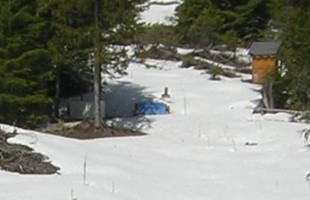 When I came in sight of the land, the snow was gone off the north hill but still deep in the low areas. Here's a detail from the photo I took. The outhouse is looking good, the tarp is still covering my wood, but to the left of that is the dead fridge I use for storage -- on its side! Apparently it was knocked over by a bear, maybe months ago.
When I came in sight of the land, the snow was gone off the north hill but still deep in the low areas. Here's a detail from the photo I took. The outhouse is looking good, the tarp is still covering my wood, but to the left of that is the dead fridge I use for storage -- on its side! Apparently it was knocked over by a bear, maybe months ago.I pushed it back up, and now I just had to open the combination lock. I had put it on as a purely psychological deterrent against human thieves, and I had written the combination on the back, in case I forgot it, and so that smart thieves wouldn't break the latch, which would only take seconds with a hammer. But I didn't want to break the latch, and the ink on the back had been dissolved in melting snow, and now I couldn't remember the combination!
I know a trick for opening Master locks -- you can feel out the third number, and the first two numbers have a certain mathematical relationship to the third, so you only have to try less than 100 combinations. But the lock was partially corroded so I couldn't feel the third number. I thought I remembered it was 18, and that at least one other number was in the 20's, so I tried a bunch, but nothing worked. Then I tried making a shim with a calendar card from my wallet, but it was both too thick and too weak -- you really need an aluminum can, which I didn't have. Finally, I noticed that the back plate was flimsy, and I pried it off with my Hori Hori digging tool. Behind that was a much stronger plate, but there was an opening through which I could look in and see the wheels, so now I could get the combination by turning the dial until the gaps lined up in the right spot. 6-16-38 -- my memory had completely failed!
Inside the fridge was a mess. Everything was wet, I had about $30 in books which were ruined, all the cardboard was moldy, and the silica gel crystals I was using to keep it dry were scattered everywhere. Luckily, most of the food was in glass jars, which were all intact and sealed. The bear had also found my smaller Coleman cooler, figured out the latch, and scattered its contents all over the ground, but that food was also in glass jars, which the bear couldn't open and wasn't smart enough to break. Praise the jar!
Dealing with the bear damage probably took two hours, and then I still had to plant the trees: one Arctic Jay nectarine, one Tomcot apricot, two Autumn Brilliance serviceberry hybrids, and a goumi. But the holes I dug last fall to plant them in were still hidden under three feet of snow! For the nectarine, I just dug a new hole in a snow-free location where my Veteran peach died two years ago -- hopefully it wasn't the location that killed it! But for the apricot I had to find the hole.
I started digging where I thought it would be, and it wasn't. The snow was soft and wet -- easy to dig the shovel into, but pretty heavy. And I didn't have a snow shovel, just a regular shovel. There was no way I was going to dig up a whole 20 by 20 foot area, and anyway nowhere to put the snow. So then I got the idea of using one of the copper pipes left over from the spring project to probe for the hole. It was like playing Battleship. But I still couldn't find it, and I started to doubt my memory of even digging the hole. I persisted, and when I finally found it, I should have trusted my past self, because the location made a perfect equilateral triangle with the two cherry trees.
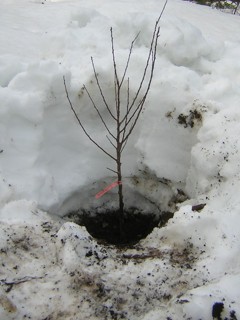 Here's the apricot in its new home. The goumi hole was easier to find. But another problem was filling the holes. Both of them had mounds of fill dirt piled nearby, but I didn't know in which direction, and I wasn't going to dig three foot deep snow in a three foot radius to find them, so I had to haul in dirt from other places. Also, I had planned to improvise the locations of the serviceberries, but I couldn't do that in the snow. Luckily they were both small plants, so I put them in a pot with soil, where they should do fine for another month.
Here's the apricot in its new home. The goumi hole was easier to find. But another problem was filling the holes. Both of them had mounds of fill dirt piled nearby, but I didn't know in which direction, and I wasn't going to dig three foot deep snow in a three foot radius to find them, so I had to haul in dirt from other places. Also, I had planned to improvise the locations of the serviceberries, but I couldn't do that in the snow. Luckily they were both small plants, so I put them in a pot with soil, where they should do fine for another month.I almost forgot the worst news: my apple trees were nearly destroyed. As far as I can figure, it happens like this: snow falls six feet deep, the limbs of the young trees are embedded in the snow, and then over time the snow compacts, and the limbs get pulled downward and broken off. Almost all the side branches on the apple trees were broken off where they met the trunk, and I lost a few cherry tree branches too. I don't even know how the smaller plants did because they're still buried. My whole orchard project might be like a suicide military invasion, where I just keep throwing plants in the ground year after year, and eventually a few lucky and strong ones will make it through.
Six Plantings -- 2 May 08 -- I was dreading this trip to the land, because my last trip was such a disaster. But I had to go because my seedlings from St. Lawrence came: two black walnuts and two highbush cranberries, plus I had left two Amelanchier x grandiflora in a pot up there because the place I wanted to plant them was still under two feet of snow.
This trip went a lot better. I knew that I could drive more than a mile in before I had to get out and walk, I found a nice place to leave the car, and most of the snow was melted off the access road. This time, instead of being covered with snow, the land was covered with water -- the central trail was a stream and there were pools everywhere. One of the places I had planned to put a walnut was totally submerged, and the other was awfully wet.
I went ahead and used the less swampy spot, and I dug a new hole in a much drier spot for the other walnut. Last spring the walnuts survived the wet -- it was the dry summer that nearly killed them all. I figure if I can get them through two or three years their taproots will find ground water.
The highbush cranberry is a species I specifically picked to go in spots that are swampy in the spring, so I planted both of them in holes of water which I then filled up with dirt and compost. And I put the Amelanchiers on either side of the path going up to the cabin site from the trail. They're probably the most decorative thing I've planted, but still with good fruit.
Also I walked around and checked out the other plants. The good news is, all six apples and four cherries have a shot at survival. The worst off is the Ashmeads apple, which would be finished except that last summer it made a sprout from the bottom which I didn't cut, because I planned to use a rooter pot to separate it from the main tree and see what happens if I grow Ashmeads on its own roots. Now I'll have to leave it as the last surviving part of the tree!
The bad news is, both peaches appear to be dead. I've grown Veteran peach from two nurseries in two locations and both died, so I won't try that variety again. But the big surprise was the Reliance peach, which had doubled in trunk diameter since I planted it, and last year produced five delicious peaches. It didn't seem to be sick, and this winter was not especially cold, just super-snowy. So I have no idea what killed it. Both peaches were also from bargain nurseries, so I will continue to try peaches but next time from Raintree.
Extending the Spring -- 18 May 08 -- On my last trip to the land a week ago, a guy was grading the road as I was walking in, so this time I knew I could drive all the way in, and I brought up three bags of compost, which I'm beginning to hoard because the price has gone up 20% since last year.
Also, it's been hot! Yesterday and today it was over 90 degrees (32C) in Spokane, which used to never happen here in May. Combine that with lingering water from the unusually wet winter, and the land was thick with mosquitos. I got bit more than 40 times, but I've discovered that if I immediately rub saliva into every bite, it greatly reduces both the severity and the duration of the itch.
I've noticed that the pipe I installed last year (for details scroll to the bottom of this archive) to take water straight from the spring source before it wells up into the algae-filled main pool, and drop it into a lower pool, has been running awfully slowly. There was more water overflowing the top of the main pool than coming through the pipe. The way to fix that is to "blow out" the pipe, to literally put my mouth on it and blow water and air through it backwards. That should increase the flow for a few months, but also, it shifts the pipe from trickle mode into siphon mode, and greatly increases the flow for a day or two until the top pool is mostly emptied and it goes back to trickle mode.
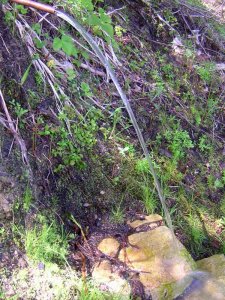 This photo shows how much water comes out in siphon mode, and you can click
here for a big photo that shows the water flowing into the lower pool. Last year when I did this, a lot of water overflowed the lower pool and ran down the trail. I'd like to get the overflow into a third pool, and I thought about turning the trail into a stream and building a bridge over it, but that's a huge job, and I decided instead to build some kind of tiny streambed that would take the water over the trail at the top. And when I saw how slow the pipe was running, I decided to do it on this trip.
This photo shows how much water comes out in siphon mode, and you can click
here for a big photo that shows the water flowing into the lower pool. Last year when I did this, a lot of water overflowed the lower pool and ran down the trail. I'd like to get the overflow into a third pool, and I thought about turning the trail into a stream and building a bridge over it, but that's a huge job, and I decided instead to build some kind of tiny streambed that would take the water over the trail at the top. And when I saw how slow the pipe was running, I decided to do it on this trip.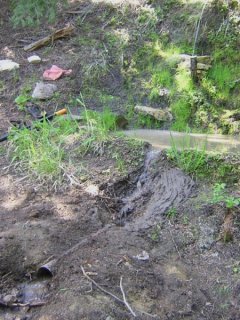 Last year Matt had to walk to the top of the ridge to get cell phone reception, and he brought back some stuff he found up there, including a section of steel pipe, 3 inches wide and around 18 inches long. It suddenly occurred to me that it would be perfect for taking the water under the trail. Here's the whole setup. After I took the photo I packed more dirt over the top of the pipe and also put some rocks in the bed above and below it to slow the flow down and protect the dirt from eroding too much.
Last year Matt had to walk to the top of the ridge to get cell phone reception, and he brought back some stuff he found up there, including a section of steel pipe, 3 inches wide and around 18 inches long. It suddenly occurred to me that it would be perfect for taking the water under the trail. Here's the whole setup. After I took the photo I packed more dirt over the top of the pipe and also put some rocks in the bed above and below it to slow the flow down and protect the dirt from eroding too much.It would be great to extend the spring all the way down through the land in a series of shaded pools, but unless the climate gets wetter, that's impossible in the dry months, and even to do it in May I'd need to get enough clay and organic matter underneath the flowing water to keep it from soaking into the sandy ground. My goal for this year is just to establish a third pool.
 June, Wood, Visitors -- 10 June 08 -- June is the prettiest month on the land, when the plants are in full leaf but haven't started turning brown for summer yet. Here's the north hill at its best. Those white flowers are mallow ninebark, which is more prominent on the north hill than it was a couple years ago.
June, Wood, Visitors -- 10 June 08 -- June is the prettiest month on the land, when the plants are in full leaf but haven't started turning brown for summer yet. Here's the north hill at its best. Those white flowers are mallow ninebark, which is more prominent on the north hill than it was a couple years ago.I haven't started any big projects yet this year, but I see one that may put off the cabin again. When I bought the land it was covered with logging debris, and I spent most of the first year throwing it into piles so I could walk around. But even where I didn't throw it into piles, it's breaking down very slowly. In winter it's too cold for wood to decompose, and in summer it's too dry. And the wood keeps falling. In the winter a big dead grand fir fell almost on where the tent was last year, and a leaning cedar collapsed under snow and led to two more brush piles where I threw the limbs I cut off it and the smaller trees it broke. Now I see why I sometimes find old charcoal when I'm digging. The main way that nature gets rid of dead wood in this region is not decomposition but burning. My range of hills will burn again, and the more dead wood there is on my land, the hotter it will burn there and the more of my fruit trees and buildings will be destroyed.
So I need to do some preemptive burning. I'd like to do a broad, slow fire in the "parking lot" area, to maximize the production of charcoal, which is an excellent soil additive and one of the best ways to sequester carbon. But by the time I have my first long stay in July, it may be too dry to burn safely. At the very least I'll need two people, one to bring wood to the fire and one to watch the fire with some buckets of water in case a spark goes too far astray.
This leads to the next subject: visitors. Angie asks:
Have you ever considered hosting a "camping trip" on your land, you know, like bring a bunch of friends up to help you get through a few big projects and in return you give them a camp-out adventure and maybe some beers or whatever?
Yes, but my land is remote! It's more than six hours from Seattle, it's not realistic to visit without a car, and anyone who can afford to own a car can't get time off work to visit. But I might as well put out an appeal:Come work and play in beautiful (in June) wilderness (logged for probably the third time in 2002). The land is nestled on the floor of a rugged canyon (climb for cell phone reception), features hundreds of trees (almost all less than ten inches in diameter), acres of wild strawberries and thimbleberies (total annual fruit production one pound) and oregon grapes (sour as lemons). Improvements include a year-round drinkable spring (drinkable also by mosquito larvae), a sheltered composting toilet (a toilet seat on a bucket in a box in a crude shed), and a rustic camp kitchen (stick-burning stove on a stump). Camp anywhere (in a tent you bring yourself, after you clear the sticks away). Wildlife include deer, moose, turkeys, chipmunks (will chew bags open for nuts and chocolate), an occasional black bear (they hardly ever eat people) and mountain lions (which you will never see, but they can see you).
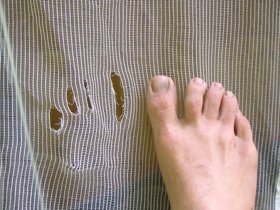 Seriously, you're all welcome to visit. I should be up there for most of late July and August. I've got some quinoa and red wheat, and otherwise you have to bring your own food. And you don't really have to do any work. Email me for more details at (my name as one word) at gmail. And here's a photo of where the bear mauled the bug screen on the outhouse, with my foot for size comparison. See, it's pretty small (for a BEAR).
Seriously, you're all welcome to visit. I should be up there for most of late July and August. I've got some quinoa and red wheat, and otherwise you have to bring your own food. And you don't really have to do any work. Email me for more details at (my name as one word) at gmail. And here's a photo of where the bear mauled the bug screen on the outhouse, with my foot for size comparison. See, it's pretty small (for a BEAR). Dead Apricots, Lazy Deer -- 28 June 08 -- Yesterday I went up to the land after being away for two weeks without rain. I had a dream that the Chinese Sweet Pit apricot died, even though it did fine last year. I got up there, and sure enough -- all the upper leaves are toasted, although a couple new sprouts low on the tree are still looking good. The new Tomcot apricot is also dead, along with both of the peaches I put in two years ago, three of four nanking cherries, and five of six original black walnuts. But the sixth, unexpectedly, has a bunch of new leaves. I'm thinking I accidentally planted it over some underground water, which it found with its taproot. The apples and cherries are also recovering nicely from the hard winter, the new apple serviceberries are doing fine, and the new highbush cranberries are thriving.
Highbush cranberries and serviceberries are native to the region, and although apples and cherries are not, they're grown commercially with great success only 100 miles to the west. Apricots and peaches are grown in the same region, not quite as successfully, but I want to keep trying them, maybe next time in different spots.
With food prices rising, and my savings falling as I put it into stuff with more enduring value than dollars, I've been a bit worried about dying of starvation if we get a hard crash. Now I'm less worried, because I've got a good crossbow, and I saw a bunch of deer on this trip. A young one bounded away with incredible springs through the air, and a couple adults did totally half-assed jobs of running away. They seemed to be thinking, "That human is obviously harmless but I suppose I should go stand behind these trees, whatever." If I ever get serious about hunting, my biggest problem will be how to preserve all the meat. [A reader suggests: cut it into thin strips, soak it in salt water, and hang it up to air dry.]